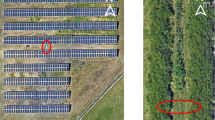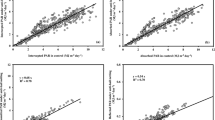Summary
The partitioning of solar and net total irradiances between the canopy and soil was measured in mixed and chamise chaparral in southern California. The solar and net total irradiance absorbed within the canopy was a relatively constant fraction throughout the year. Variations can be explained by the changing path length of the solar beam as the solar altitude varies. The increased fraction of solar irradiance in winter, combined with the lower incident solar irradiance, produced a wide fluctuation of solar irradiance at the soil surface through the year. Although incoming solar irradiance on the bare soil surface is less on the north-facing slope than on the south-facing slope, the absorption of solar irradiance is greater in the canopy of the mixed chaparral on the north-facing slope because greater leaf and stem area has developed.
Similar content being viewed by others
References
Acock B, Thornley JHM Warren Wilson J (1970) Spatial variation of light in the canopy. In: Predction and measurement of photosynthetic productivity, Wageningen: Centre for Agricultural Publishing and Documentation p 91–102
Anderson MC (1966) Stand structure and light penetration. II. A theoretical analysis. J Appl Ecol 3: 41–54
Aschmann H (1973) Distribution and peculiarity of mediterranean ecosystems. In: F di Castri, HA Mooney, (eds) Mediterranean type ccosystems: Origin and structure, Springer New York-Berlin-Heidelberg p 11–19
Budyko MT (1956) The heat balance of the earth's surface. [Translation PB131692. U.S. Department of Commerce, Office of Technical Services, Washington, D.C.] Gidrometeorologicheskoe izdatel stro (Leningrad). Izv. Akad. Nauk U.S.S.R. Series B3, 17 (1954)
Duncan WC, Loomis RS, Williams WA, Hanau R (1967) A model for simulating photosynthesis in plant communities. Hilgardia 38: 181–205
Gates DM (1962) Energy exchange in the biosphere. Harper and Row New York
Gates DM (1965) Energy, plants and ecology. Ecology 46: 1–13
Giffin JR (1973) Xylem sap tensions in three woodland oaks of central California. Ecology 54: 152–159
Horton JS (1941) The sample plot as a method of quantitative analysis of chaparral vegetation in southern California. Ecology 22: 457–468
Jones R (1968) The leaf area of an Australian healthland with reference to seasonal changes and the contribution of individual species. Aust J Bot 16: 579–588
Krause D, Kummerow J (1977) Xeromorphic structure and soil moisture in the chaparral. Oecol Plant 12: 133–148
Martin HA, Specht RL (1962) Are mesic communities less drought resistant? A study of moisture relationships in dry sclerophyll forest at Inglewood, South Australia. Aust J Bot 10: 106–118
Miller PC (1979) Quantitative plant ecology. In: D Horn, GR Stairs, RD Mitchell (eds). Analysis of ecosystems Ohio State University Press, Columbus p 179–231
Miller PC (1980) Resource use by chaparral and matorral: A comparison of vegetation function in two mediterranean type ecosystems. Springer Verlag New York-Heidelberg-Berlin in press
Miller PC, Mooney HA (1976) The origin and structure of American arid-zone ecosystems. The producers: Interactions between environment, form, and function. In: CT de Wit, GW Arnold (eds), Critical evaluation of systems analysis in ecosystems research and management Centre for Agricultural Publishing and Documentation Wageningen p 38–56
Miller PC, Poole DK (1979) Patterns of water use by shrubs in southern California. For Sci 25: 84–98
Miller PC, Stoner WA, Tieszen LL (1976) A model of stand photosynthesis for the wet meadow tundra at Barrow, Alaska. Ecology 57: 411–430
Miller PC, Bradbury DE, Hajek E, LaMarche V, Thrower NJW (1977) Past and present environment. In: HA Mooney (ed) Convergent evolution in Chile and California, mediterranean climate ecosystems Dowden, Hutchinson and Ross Stroudsburg, Pa. p 27–72
Miller PC, Hajek E, Poole DK, Roberts SW (1980) Microclimate and energy exchange. In: PC Miller (ed) Resource use by chaparral and matorral: A comparison of vegetation function in two mediterranean type ecosystems Springer-Verlag New York-Heidelberg-Berlin in press
Mooney HA, Ed. (1977a) Convergent evolution in Chile and California, mediterranean climate ecosystems. Dowden, Hutchinson and Ross Stroudsburg, Pa
Mooney HA (1977b) Southern coastal scrub. In: MG Barbour, J Major, (eds) Terrestrial vegetation of California John Wiley New York p 471–489
Mooney HA, Dunn EL (1970) Photosynthetic systems of mediterranean climate shrubs and trees of California and Chile. Am Nat 104: 447–453
Mooney HA, Dunn EL (1970) Convergent evolution of mediterranean climate evergreen sclerophyll shrubs. Evolution 24: 292–303
Ng E (1974) Soil moisture relations in chaparral. State University M.S. Thesis, San Diego
Ng E, Miller PC (1980) Soil moisture relations in the southern California chaparral. Ecology 61: 98–107
Orshan G (1963) Seasonal dimorphism of desert and mediterranean chamaephytes and its significance as a factor in their water economy. In: AJ Rutter, FH Whitehead (eds), The water relations of plants John Wiley New York p 206–222
Parsons DJ, Moldenke AR (1975) Convergence in vegetation structure along analogous climatic gradients in the mediterranean climate ecosystems of California and Chile Ecology 56: 950–957
Steward D, Webber PJ (1980) The plant communities and their environments. In: PC Miller, (ed) Resource use in chaparral and matorral Springer New York-Berlin-Heidelberg
Syvertsen JP (1974) Relative stem water potentials of three woody perenials in a southern oak woodland community. Bull So Calif Acad Sci 73: 108–113
Thrower NJW, Bradbury DE (1977) Chile-California mediterranean scrub atlas: A comparative analysis Dowden, Hutchinson and Ross Stroudsburg, Pa
van Keulen H (1975) Simulation of water use and herbage growth in arid regions. Centre for Agricultural Publishing and Documentation Wageningen
Wit CT, de (1965) Photosynthesis of leaf canopies. Agric Res Rep (Wageningen) 663
Zohary M (1962) Plant life in Palestine, Israel and Jordan. The Ronald Press New York
Author information
Authors and Affiliations
Rights and permissions
About this article
Cite this article
Miller, P.C., Poole, D.K. Partitioning of solar and net irradiance in mixed and chamise chaparral in southern California. Oecologia 47, 328–332 (1980). https://doi.org/10.1007/BF00398525
Received:
Issue Date:
DOI: https://doi.org/10.1007/BF00398525




